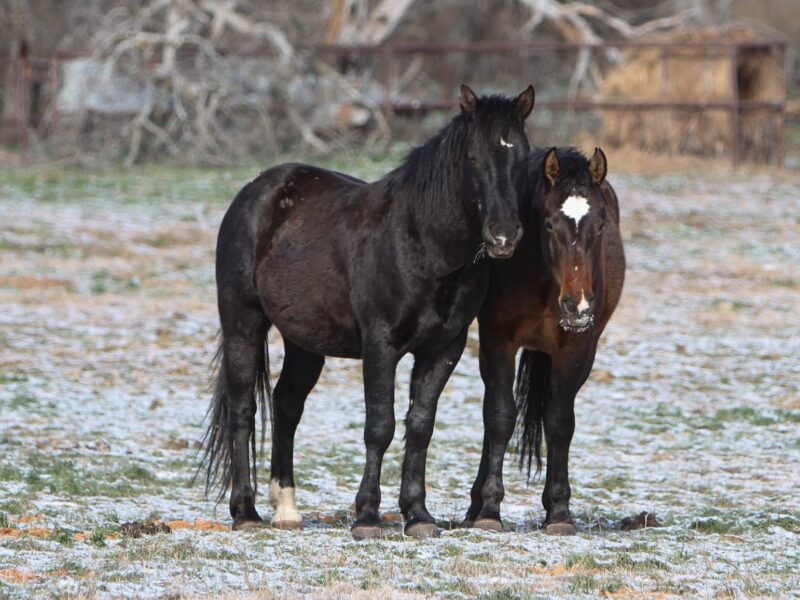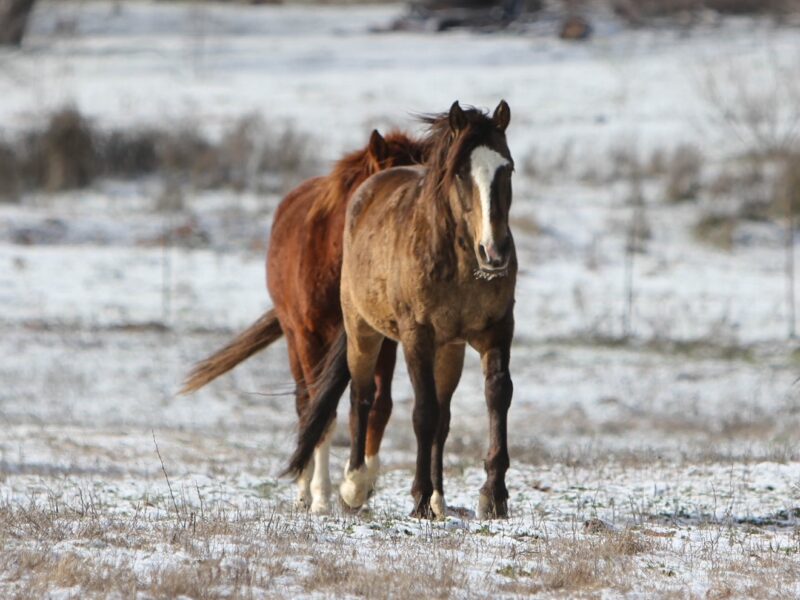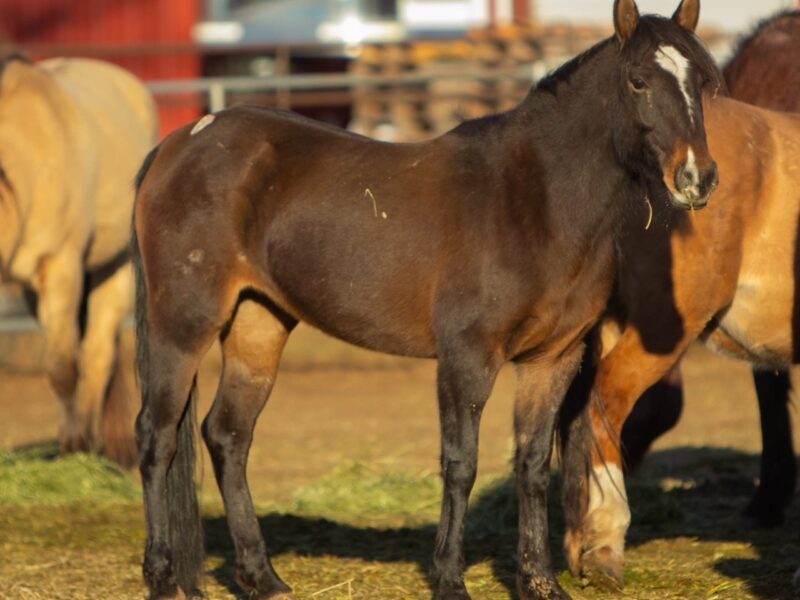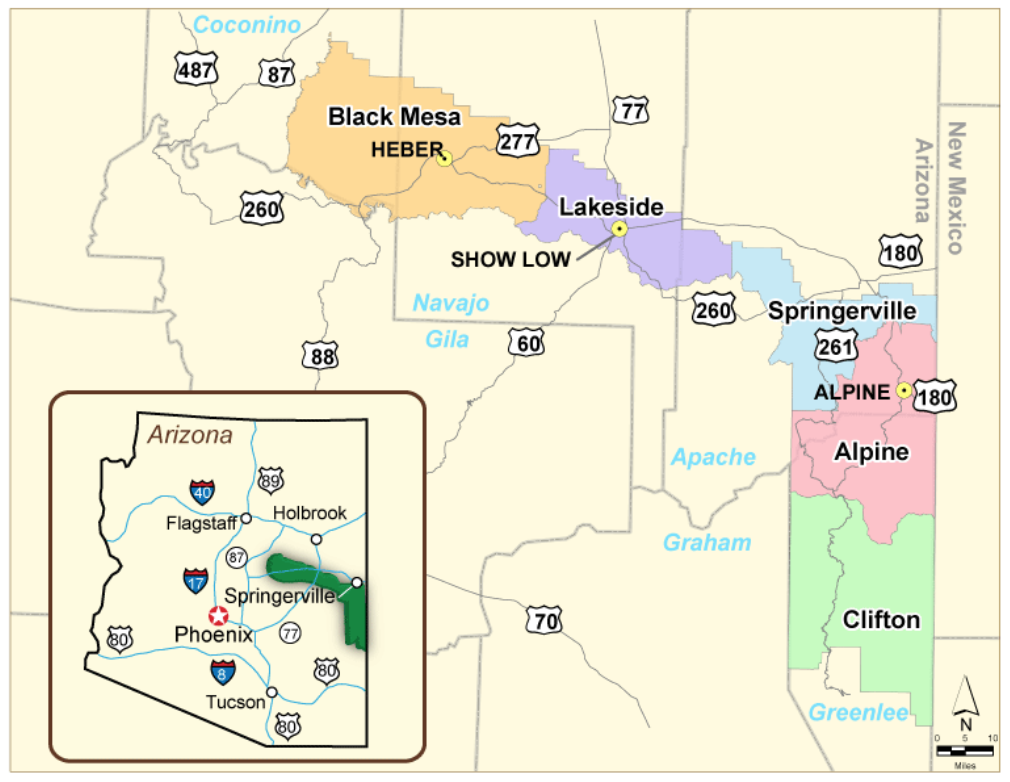From Arizona to Texas to California: Follow the Alpine wild horse rescue
Alpine geldings—Click for full image
Alpine mares
The U.S. Forest Service (USFS) originally captured the horses in a bait-and-trap roundup in the Apache National Forest in Arizona. Previously, the agency had sold wild horses captured in the Alpine Ranger District at a public auction in Holbrook, Ariz., or on the website of the contractor, which offered photos and limited information about the horses. Another wild horse advocacy organization, the Salt River Wild Horse Management Group, had bought and adopted out 270 horses to new homes and sanctuaries.
However, it appears that in July 2023 there was a breakdown in the relationship and communication between stakeholders, the agency, and contractors involved in bait-trapping the horses. This resulted in the USFS attempting to follow the letter of the law that “trespass livestock be offered at sale by directing the contractor to take captured horses out of state for auction. The USFS stated that they were not doing so in the hopes that the horses would be bought for slaughter, but rather that they would be purchased at the sale.
USFS has cited the following challenges that the agency says have made it challenging to have a successful working relationship with wild horse advocates: misrepresentation on adoption applications, lack of funding, horses not being picked up or being returned, captured horses being released back onto forest lands.
Advocates have expressed concerns that: the horses are being removed at all, there is bias with regard to being allowed to register for the online adoptions, horses are being taken out of state to an auction yard, tracking the horses down is difficult, some sanctuaries have tried to register to keep bonded horses they knew on the range together and have been sad and frustrated haven’t been allowed to do that.
The USFS first began removing about 400 horses from the forest in 2022 after reaching a 2021 stipulated agreement in federal court with the Center for Biological Diversity and Maricopa Audubon Society, which had sued over the horses’ impact on the endangered New Mexico meadow jumping mouse and other federally listed species in the Black River watershed.
The Alpine horses are not afforded protection under the 1971 Wild Free-Roaming and Burros Act. The law directed the USFS to identify unclaimed horses or burros located on the lands they manage, but there were none in the Apache National Forest at the time of the act’s passage, according to the USFS.
At the time that Congress passed the Act, horses were found in Sitgreaves National Forest. That resulted in the establishment of the Heber Wild Horse Territory.
The USFS contends that the horses did not migrate to the Alpine, Ariz., area from the Heber, Ariz., area herd, which is located more than 100 miles away by road.
Rather, the USFS says, the horses are unauthorized livestock that most likely came from outside the forest, including from the neighboring Fort Apache Indian Reservation.
In 2011, the Wallow Fire, the largest wildfire in Arizona history, burned through nearly 538,000 acres of the forest. It destroyed about 14 miles of the 19-mile boundary fence that would have kept the horses from entering USFS-managed public lands. Unbranded cattle were removed, but the tribe did not claim the unbranded horses.
The 2021 court agreement, federal law, and state law regarding unauthorized livestock all pointed to the removal and sale of the horses, deemed “unauthorized livestock,” and that USFS could not give the horses away, the agency said.
Wild horse advocates and some local residents argued that the horses were part of historic herds dating back to Spanish explorers and that the USFS was removing the horses in order to increase grazing of private livestock on public lands.
The agency said that the concerns caused by the horses were not within an active grazing allotment and that damage was increased because the horses were there year-round. Suggestions that the horses be managed with fertility control were rejected.
“We’re not into the business of managing unauthorized livestock,” said Robert Lever, forest supervisor of the Apache-Sitgreaves National Forest, was quoted as saying. “We have an Endangered Species Act that we need to follow.”
The USFS entered into conversations with a number of wild horse advocacy groups, including Return to Freedom, with the stated goal of reducing the chances that horses would flood the local market and be bought by kill buyers. RTF tried to persuade the agency that it need not follow the timeline for unauthorized livestock sale under state law but the agency’s attorneys believed that Arizona law was congruent with federal law and USFS policy.
Map credit: USFS. To see an interactive map of the region, click the image
Stepping up to help horses in need
On Dec. 3, 2023, Return to Freedom and fellow nonprofit organization All Seated in a Barn set out to save 45 Alpine wild horses at a Bowie, Texas, auction from which many, especially the stallions, could have been shipped to slaughter.
A day earlier, All Seated in a Barn was working to rescue seven Alpine weanlings and yearlings along with 50 foals brought in to sell from the Navajo reservation. We contacted Tahlia Fischer of All Seated in a Barn after learning that there were dozens of adult horses — band stallions and their mares — along with what appeared to be a number of bachelor colts. We asked whether anyone had stepped up for the Alpine harem band stallions and their mares.
We asked Fischer if she thought we’d be able to get the whole group to safety if we worked together. We committed to taking the stallions and their band mares for sanctuary and to do whatever we could for the 11 bachelor boys, while All Seated in a Barn had already committed to finding good adopters for the seven yearlings and weanlings. All Seated in a Barn agreed to jump in with us to save as many Alpine horses as we could.
Fischer made it very clear that she would only proceed to purchase the horses at auction if she had enough additional money in hand to cover transport, quarantine, veterinary care, feeding and care for each horse through April. With winter already upon us, All Seated in A Barn had three facilities organized and staffed in Texas to let the horses decompress, receive any needed medical care and have the stallions gelded. They would ready the horses for shipping to California after the muddy season passed and pasture fencing was added at our sanctuary for dozens of new horses, including pregnant mares.
Over the next 24 hours, in an amazing show of support from online donors, the two organizations were able to raise $50,000 to purchase 20 stallions (11 of them bachelors) and 18 mares.
Simone Netherlands of the Salt River Wild Horse Management Group, an Arizona-based nonprofit wild horse organization, contacted us immediately and joined forces to save as many Alpine horses as we could. The support from SRWHMG has been invaluable, with their team helping to identify Alpine horses in their database from the range to match up harem band stallions with their mares, and to see if we could reunite any stranded foals orphaned after this ordeal with their rightful mares.
In just a few days, the three groups had raised an amazing $158,339 — just over $3,500 per horse — from generous donors.
On Dec. 3, four of the stallions were successfully bid on and purchased at the auction by a group we did not know, Red Orchard Animal Rescue, a Texas sanctuary. All Seated in a Barn was able to provide $3,500 raised for each of the stallions to assist them with initial costs since the funds were raised specifically for the Alpine horses.
About a week later, a few more Alpine horses rolled into Bowie holding corrals including three stallions and three mares. With the help of SRWHMG we were able to identify these horses. The handsome bay stallion is Coronado, and lucky for him, his three harem band mares Eleanor, Stormy and Zamora were here with him so we were able to put them back together in the same corral as soon as Coronado healed from gelding!
The two other stallions were immediately identified as Phoenix and Blizzard. SRWHMG was able to track down their mares that were previously adopted in an earlier online auction to Wild Horse Refuge in Colorado. The Refuge agreed to take the two stallions and reunite them with their band mares after the stallions were gelded. The stallions were shipped mid-February 2024 and have already jumped out of the trailer to win their mares back!
Dec. 3, 2024 Bowie, Texas, auction: 45 Alpine Horses
- 20 stallions (16 bid on and bought by All Seated in a Barn; four bid on and bought by Red Orchard Animal Rescue)
- 18 mares (all bid on, bought by All Seated in a Barn)
- 7 weanlings/yearlings (all bid on, bought by All Seated in a Barn)
+ One week later:
- 3 stallions, Coronado, Phoenix, Blizzard (all bid on, bought by All Seated in a Barn)
- 3 mares, Eleonore, Zamora, Stormy. (Due to injury, Eleonore was not run through auction. She was titled to ROAR by USFS contractor. All Seated in a Barn bid on and bought Zamora and Stormy).
TOTAL = 46 Alpine horses (19 stallions, seven weanlings and 20 mares, most of them pregnant) were bid on and purchased by All Seated in a Barn. They will be transported to an Return to Freedom location in late spring 2024.
Without the two facilities owned by All Seated in a Barn and another leased facility, and the caring team in place, this rescue would not have been possible. The horses are receiving quality feed and care and the local veterinarian is responsive and skilled with unhandled horses.
An RTF volunteer traveled to Texas in mid-January for three days and was very moved by the attentiveness to detail. The horses always have a large round bale of quality grass hay and are fed alfalfa twice per day to help keep their weight up in the winter cold. They receive grain daily and mineral supplements.
Our volunteer reported that the horses looked healthy, with good weight on them and shiny winter coats. Water troughs are well-maintained with any ice broken three to five times per day. They all have plenty of room to roll, play and get into mischief. When our volunteer visited the horses in January, she found that not only the weanlings and yearlings but some of the bachelor colts were curious and friendly.
The stallions are located on 20 acres with another 20 they can be rotated to, with trees and other windbreaks for shelter. The youngest are able to stay in a barn during cold weather. We have confirmed the seven weanlings and yearlings have not yet reconnected to any of the mares and, thanks to the help of SRWHMG, these youngsters do not belong to these mares.
Some extra veterinary care
Since leaving the adoption yard, the Alpine horses have proved to be a very resilient herd. A number left the auction with a serious cough. They were checked on regularly by a veterinarian and all did well on antibiotics.
All stallions were gelded with one (Blackstone) needing a crypt orchid surgery. All boys have recovered perfectly!
- Merlin, a popular gray stallion, went through his gelding fine but had to return to the vet for about a week for antibiotics and help with draining. He did really well and is back with the boys in their large pasture.
- Blackstone has been Merlin’s long time “lieutenant” on the range, helping the grey stallion manage his band. We discovered that Blackstone was a cryptorchid (meaning one testicle hasn’t descended and has retained one or both testicles in the inguinal canal or abdominal cavity). To successfully geld a cryptorchid requires a more complicated surgery in a sterile environment. We are happy that this loyal guy had a successful surgery in mid February and will be returned to Merlin’s side very soon.
One of Coronado’s mares, Eleonore, slammed into a panel and scraped her face down to the bone while being run through the chute at the auction yard for her pre-check. After the incident, ROAR was on site and the contractor, who still held Eleonore’s title, gave ROAR permission to transport the mare to the vet.
A few days later, Eleonore was titled over to ROAR, which has expressed to RTF and the other organizations involved that it intends turn her title over to RTF when Eleonore is recovered enough to be reunited with her natural family, Coronado’s band. She has improved and we hope that she will be returned to her band soon.
Next steps: Now that the rescue is over, sanctuary work begins
This was a large rescue with many moving parts. Now that the rescue has been successful, years of work and commitment now begin for RTF. We will need sponsors for these horses to support their ongoing sanctuary and care.
As we prepare for their eventual move of the Alpine horses to California, we continue working closely with SRWHMG to identify as many of these beautiful horses as we can so that we can feature them on this page and make individual sponsorships available.
None of the weanlings are bonded to any of the mares we have, nor are they the offspring of any of the mares. The seven are 6-12 months old, curious and friendly. They will be available to approved homes through RTF’s adoption policy. RTF only places bonded horses in groups of two or more to adopters who can provide a safe equine environment for them to be socialized and enjoy a good quality of life.
We found that many of the bachelor stallions, now geldings, are as young as 2-6 years old. They are curious and friendly. In the event that they socialize naturally with humans, we will be looking for specific bonds among two or more horses over time. If there is an appropriate placement for two or more horses at a time, only then we will consider it.
When we are able to find the right forever homes for two or more horses, it helps us provide a lifetime of sanctuary for horses that are more difficult to place or are part of a larger band. Our specific focus is on mature band stallions and their harem of mares. If there are young horses who do not want to interact with people or that have a lot of trauma, they most likely stay at the sanctuary. In keeping with longstanding RTF policy, any horses that do not wish to socialize with humans are not forced to do so and will be absorbed in the sanctuary.
Before any decisions are made, we will have to take time to get to know the horses and their personalities, address their specific needs, and take into account their emotional bonds as a priority. We have a strict adoption policy and bonded horses stay together. This has often limited our ability to place horses since most adopters do not want to take on two or more horses. The sanctuary absorbs those horses.
Again: All of those decisions will be made further down the road and will be informed by getting to know each horse as an individual.
We have communicated directly with the U.S. Forest Service to address some of the conflict between the agency and wild horse advocates in hopes that it will be easier to ensure Alpine horses will be available to sanctuaries and individuals with good homes to avoid having them hauled to auction houses. It is our understanding that the contractor has set up an online auction and as long as advocates act respectfully they will be invited to participate in the online auction. Hopefully, we can avoid the horses being hauled at great expense and stress to the animals out of the area for public sales (for more on the legal status of the horses, see Background).
We understand everyone’s emotions and frustrations, and we wish the horses could remain free in the National Forest, but the sad truth is that they’re being removed under a 2021 stipulated agreement in federal court and sent to auction under state law. The best that we can do is improve the way that we all work together with respectful communication, as hard as it may be, so that we can find solutions and a safe landing for all the Alpine horses as they continue to be removed from USFS-managed lands. It would serve the horses best to work together for the longtime safety and positive outcome for each and every Alpine horse.
We are grateful to be working with such devoted partner organizations and are hugely appreciative of all those who have donated and who care so deeply about the Alpine horses. If All Seated in a Barn did not have two leased and staffed facilities and an additional pasture lease, none of this would have been possible. If RTF did not say that we would take on family bands, this would not have been possible. And without Salt River Wild Horse Management Group, we would not have been able to sort out the horses. Most certainly this would not have been possible without all of the wonderful donors who gave to prevent these horses from being sold to slaughter.
All Seated in a Barn has an accounting team and CPA managing all income and expense invoices from the rescue and has made everything transparent to RTF and SRWHMG. To date, the funds are being used as expected: purchase of horses at the auction, veterinary care including gelding, antibiotics, crypt orchid surgery, feed, hay, supplements, board, labor/care/cleaning, transportation.
All Seated in a Barn’s profit-and-loss statements for the Alpine rescue are here: December 2023, January 2024.
If you would like to help and stay involved, please consider making a donation to help us provide ongoing care for the Alpine horses.
A frequently asked question: How is ROAR involved?
On Dec. 3, four of the stallions were successfully bid on and purchased at the auction by a group that we did not know, Red Orchard Animal Rescue, a Texas sanctuary. ROAR had been in communication with Salt River Wild Horse Management Group prior to the Bowie, Texas, auction and was amenable to working to make sure any Alpine horses that ROAR took were not harem band stallions and that those they took were bonded. All Seated in a Barn was able to provide $3,500 raised for each of the stallions to assist ROAR with initial costs since the funds were raised online specifically for the Alpine horses.
- Neither RTF or ASIAB gave, sold or adopted any Alpine horses to ROAR
- As of this writing, an Alpine mare injured at the Bowie auction, Eleonore, is recovering in the care, custody and control of ROAR. It received her title directly from the USFS contractor without going through an auction. She has not yet been reunited with her natural family band. Her title has not been transferred to RTF.
- The other Alpine horses that ROAR has in its care were purchased at online or live auctions.

























